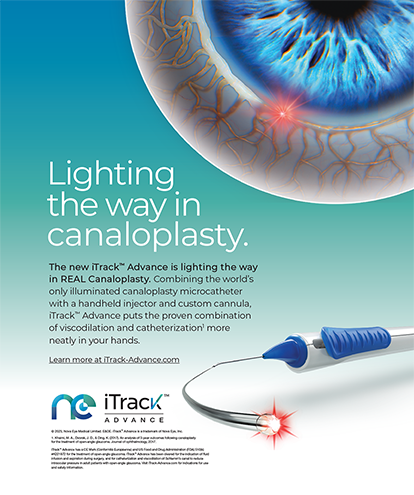Cataract Surgery | Feb 2006
The Akreos Adapt IOL
An experience-based assessment of this hydrophilic acrylic lens.
Giorgio Lofoco, MD
The Akreos Adapt IOL (not available in the US; Bausch & Lomb, Rochester, NY) has many ideal characteristics. Specifically, it is a biconvex lens that has a refractive index of 1.46, and its material is hydrophilic acrylic (a combination of HEMA and PMMA) with a water content of 26%.
The IOL's optic and haptics feature square edges that inhibit the migration of lens epithelial cells. The optic's diameter is 6mm, and the lens is available in sizes of 10.5, 10.7, and 11.0mm to accommodate lens capsules of various sizes. Table 1 shows the unique relationship of the lens' diameter and power. The foldable IOL may be implanted with an Akreos PS-27 single-use injector (not available in the US; Bausch & Lomb) or with a forceps. This article shares the results of my long-term study of the Akreos Adapt IOL.
STUDY DESIGN
My retrospective review included 632 Akreos Adapt lenses implanted between 2001 and 2004. All of the subjects had follow-up records of greater than 12 months available. Each patient had undergone cataract extraction with a self-sealing clear corneal incision and phacoemulsification.
RESULTS
Behavior of the Lens
The Akreos Adapt IOL was quite flexible and required minimal compression during folding and implantation. It unfolded in a smooth, controlled manner, whether implanted with an injector or a forceps. No capsular damage occurred.
Visual Acuity
The mean postoperative UCVA was 20/25. In patients who had no disease of the posterior segment (540 eyes), the BCVA was 20/20. Centration of the IOL was excellent.
Complications
Intraoperative miosis occurred in seven eyes, with two instances each of cystoid macular edema and incomplete capsular overlap. Postoperatively, five eyes had corneal striae that lasted more than
1 week, and 12 patients experienced ocular hypertension of greater than 21mmHg. The striae resolved after 4 weeks, and transient hypertension responded to topical therapy, which was discontinued in all cases after 2 to
8 weeks.
Posterior Capsular Opacification
In order to determine the rate of posterior capsular opacification (PCO), I measured 390 eyes with the EPCO 2000 System (available from Manfred Tetz, MD, in Berlin). The overall PCO score was 1.02, and the central posterior capsule's transparency score was 0.24. At 1 year postoperatively, only one of the 632 eyes required an Nd:YAG laser capsulotomy.
CONCLUSION
This long-term study demonstrated that the optical and physical performance of the Akreos Adapt IOL is excellent. Moreover, the square edges of the optic and haptics proved remarkably effective against the development of PCO. Given the excellent biocompatibility of the lens as well as its ease of use, I routinely implant the Akreos Adapt IOL in most cataract cases.
Giorgio Lofoco, MD, is in practice at the Ophthalmic Division, Ospedale San Pietro, Rome. He is a paid consultant to Bausch & Lomb. Dr. Lofoco may be reached at +39 63 21 51 52; lofoco@tiscali.it.


